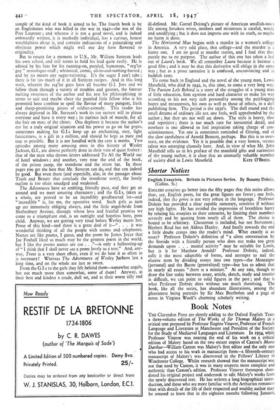Shorter Notices
ENGLISH essayists go better into the fifty pages that this series allows than, say, English poets, for the great figures are fewer ; one feels, indeed, that the genre is not very robust in the language. Professor Dobree has provided a clear capable summary, sensitive • if without any high lights. He has avoided the impression of breathless hurry by relating his essayists to their centuries, by limiting their numbers severely and by quoting from nearly all of them. The choice is bound to be arbitrary. Chesterton is included, but not Stevenson ; Herbert Read but not Aldous Huxley. And finally towards the end a little doubt creeps into the reader's mind. What exactly is an essay? Professor Dobree's definition of "a silent conversation by the fireside with a friendly person who does not make too great demands upon . . . mental activity " may be suitable for Lamb, but is it for Matthew Arnold? Professor Dobree, indeed, calls it the most adaptable of forms, and attempts to nail the elusive term by dividing essays into two types—the- Montaigne (personal) and the Bacon (generalised) type—but has to admit that in nearly all essays " there is a mixture." At any rate, though to draw the line today between essay, article, sketch, study and treatise is difficult, we can point to solid figures in the past ; and that is what Professor Dobrie does without too much theorising. The book, like all the series, has abundant illustrations, among the pleasantest being portraits by Sir Max Beerbohm and a page of notes in Virginia Woolf's charming scholarly writing.


































 Previous page
Previous page